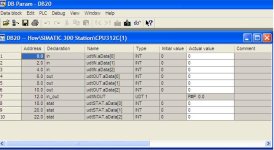PatrickG
Member
Hi Everyone,
I have a question for the Siemens programmers here.
I have been trying to recreate some of my ControlLogix boiler-plate in Step 7 and have noticed something strange. Maybe it’s just strange to me. I’m sure I’m doing something wrong.
I have two UDTs I like to use. One for the machine state (manual, automatic, etc.) and one for actuators. I happily wrote a function block with these two variables in the in/out interface. There was “Machine” of “typeMachine” and “actCylinder” of “typeActuator”.
Using this approach the block size is around 2k bytes. I thought “Wow that’s big. I’ll only be able to have 6 or 7 actuators per function block.”
Then I tried something else. I created a global DB with “Machine” and “actCylinder” in there. I made everything in the FB point at the global DB and took “Machine” and “actCylinder” out of the in/out interface. The block size went down to 626 bytes and the global DB was 180 bytes.
This approach seems to leave room for around 25 actuators. That seems better but I would like to understand why there is such a large difference.
My programs are printed out in this pdf if you care to look.
Thanks,
Patrick
I have a question for the Siemens programmers here.
I have been trying to recreate some of my ControlLogix boiler-plate in Step 7 and have noticed something strange. Maybe it’s just strange to me. I’m sure I’m doing something wrong.
I have two UDTs I like to use. One for the machine state (manual, automatic, etc.) and one for actuators. I happily wrote a function block with these two variables in the in/out interface. There was “Machine” of “typeMachine” and “actCylinder” of “typeActuator”.
Using this approach the block size is around 2k bytes. I thought “Wow that’s big. I’ll only be able to have 6 or 7 actuators per function block.”
Then I tried something else. I created a global DB with “Machine” and “actCylinder” in there. I made everything in the FB point at the global DB and took “Machine” and “actCylinder” out of the in/out interface. The block size went down to 626 bytes and the global DB was 180 bytes.
This approach seems to leave room for around 25 actuators. That seems better but I would like to understand why there is such a large difference.
My programs are printed out in this pdf if you care to look.
Thanks,
Patrick





